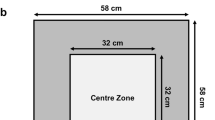Abstract
It has recently been reported that naloxone treatment, prior to initial exposure to a novel arena, results in significant behavioural change when animals are retested 24 h later. In an attempt to clarify the nature of this delayed action of the opiate antagonist, three further studies have been performed. In the first experiment, male mice were injected with naloxone hydrochloride (0–10 mg/kg, IP) immediately after their initial experience of the test arena. When retested 24 h later, all groups that had previously received naloxone exhibited greatly reduced activity and rearing, with no evidence of a dose-response relationship. In the second experiment, naloxone (0–10 mg/kg) failed to induce a conditioned place aversion when administered according to the above regimen. In the final experiment, no evidence for a naloxone-induced taste aversion to saccharin was observed. It is concluded that the behavioural changes observed in the open-field study may reflect either (a) subtle aversive properties of naloxone which are insensitive to traditional one-trial paradigms or (b) opioid modulation of memory for non-painful experiences.
Similar content being viewed by others
References
Amir S, Brown ZW, Amit Z (1980) The role of endorphins in stress: evidence and speculations. Neurosci Biobehav Rev 4:77–87
Arnsten AT, Segal DS (1979) Naloxone alters locomotion and interaction with environmental stimuli. Life Sci 25:1035–1042
Bardo MT, Bhatnagar RK, Gebhart GF (1983) Age-related differences in the effect of chronic administration of naloxone on opiate binding in rat brain. Neuropharmacology 22: 453–461
Bodnar RJ, Kelly DD, Brutus M, Glusman M (1980) Stress-induced analgesia: a review of neural and hormonal mechanisms. Neurosci Biobehav Rev 4:87–100
File SE (1980) Naloxone reduces social and exploratory behaviour in rats. Psychopharmacology 71:41–44
Izquierdo I (1979) Effects of naloxone and morphine on various forms of memory in the rat: possible role of endogenous opiate mechanisms in memory consolidation. Psychopharmacology 66:199–203
Izquierdo I, Dias RD, Souza DO, Carrasco MA, Elisabetsky E, Perry ML (1980a) The role of opioid peptides in memory and learning. Behav Brain Res 1:451–468
Izquierdo I, Souza DO, Carrasco MA, Dias RD, Perry ML, Eisinger S, Elisabetsky E, Vendite DA (1980b) Beta-endorphin causes retrograde amnesia and is released from the rat brain by various forms of training and stimulation. Psychopharmacology 70:173–177
Katz RJ, Gelbart J (1978) Endogenous opiates and behavioural responses to environmental novelty. Behav Biol 24:338–348
Leblanc AE, Cappell H (1975) Antagonism of morphine-induced aversive conditioning by naloxone. Pharmacol Biochem Behav 3:185–188
Mayer DJ, Watkins LR (1981) Role of endorphins in endogenous pain control systems. Mod Probl Pharmacopsychiatry 17:68–96
Messing RB, Jensen RA, Vasquez BJ, Martinez JL, Spiehler VR, McGaugh JL (1981) Opiate modulation of memory. In: Martinez JL, Jensen RA, Messing RB, Rigter H, McGaugh JL (eds) Endogenous peptides and learning and memory processes. Academic Press Inc. London, pp 431–443
Millan MJ (1981) Stress and endogenous opioid peptides: a review. Mod Probl Pharmacopsychiatry 17:49–67
Mucha RF, van der Kooy D, O'Shaughnessy A, Bucenieks P (1982) Drug reinforcement studied by the use of place conditioning in rat. Brain Res 243:91–105
Pert A, DeWald LA, Liao H, Sivit C (1979) Effects of opiates and opioid peptides on motor behaviours: sites and mechanisms of action. In: Usdin E, Bunney E, Kline NS (eds) Endorphins in mental health research. Macmillan. London, pp 45–61
Pilcher CWT, Stolerman IP (1976) Conditioned flavour aversions for assessing precipitated morphine abstinence in rats. Pharmacol Biochem Behav 4:159–163
Rodgers RJ (1982) Delayed effects of naloxone on responsiveness to environmental novelty in rats. Psychopharmacology 78: 230–233
Rodgers RJ, Deacon RMJ (1979) Effect of naloxone on behaviour of rats exposed to a novel environment. Psychopharmacology 65:103–105
Roth KA, Katz RJ, Schmaltz K, Sibel M (1981) Reduced behavioural activity due to opiate blockade: relations to stress. Int J Neurosci 12:59–62
Segal DS, Browne RG, Arnsten AT, Derrington DC, Bloom FE, Davis AV, Guillemin R, Ling N (1979) Characteristics of beta-endorphin-induced behavioural activation and immobilization. In: Usdin E, Bunney E, Kline NS (eds) Endorphins in mental health research. Macmillan, London, pp 307–324
Sherman JE, Pickman C, Rice A, Liebeskind JC, Holman EW (1980) Rewarding and aversive effects of morphine: temporal and pharmacological properties. Pharmacol Biochem Behav 13:501–505
Stolerman IP, Pilcher CWT, D'Mello GD (1978) Stereospecific aversive property of narcotic antagonists in morphine-free rats. Life Sci 22:1755–1762
van der Kooy D, Phillips AG (1977) Temporal analysis of naloxone attenuation of morphine-induced taste aversion. Pharmacol Biochem Behav 6:637–641
Watkins LR, Mayer DJ (1982) Organization of endogenous opiate and nonopiate pain control systems. Science 216:1185–1192
Author information
Authors and Affiliations
Rights and permissions
About this article
Cite this article
Rodgers, R.J., Richards, C. & Precious, J.I. Naloxone administration following brief exposure to novelty reduces activity and rearing in mice upon 24-h retest: A conditioned aversion?. Psychopharmacology 82, 322–326 (1984). https://doi.org/10.1007/BF00427678
Received:
Accepted:
Issue Date:
DOI: https://doi.org/10.1007/BF00427678




